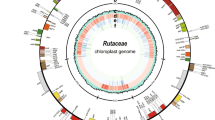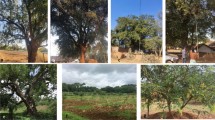Abstract
We analyzed variability of morphological characters and genetic polymorphism of inter-simple sequence repeat (ISSR) markers in nine natural populations of three Lotus species from Eastern Europe, aiming to provide insights into the nature of the species L. ucrainicus. Nuclear ribosomal internal transcribed spacer (nrITS) was used as an additional molecular marker for a small subset of accessions. Analysis of variance, and principal coordinate and principal component analyses were applied for morphological data study. Cluster analysis [unweighted pair-group method with arithmetic mean (UPGMA)], principal coordinate analysis, and analysis of population genetic structure were used for ISSR pattern study. Morphological and genetic (ISSR, nrITS) evidence suggested hybrid origin of L. × ucrainicus as a result of hybridization between tetraploid species L. corniculatus and diploid species L. stepposus. We conclude that L. × ucrainicus may represent a case of hybrid speciation in statu nascendi, occurring before our very eyes.







Similar content being viewed by others
References
Anderson EC, Thompson EA (2002) A model-based method for identifying species hybrids using multilocus genetic data. Genetics 160:1217–1229
Bleeker W, Hurka H (2001) Introgressive hybridization in Rorippa (Brassicaceae): gene flow and its consequences in natural and anthropogenic habitats. Mol Ecol 10:2013–2022
Bornet B, Branchart M (2001) Nonanchored Inter Simple Sequence Repeat (ISSR) Markers: reproducible and specific tools for genome fingerprinting. Plant Mol Biol Rep 19:209–215
Bonin A, Bellemain E, Eidesen B, Pompanon F, Brochmann C, Taberlet P (2004) How to track and access genotyping errors in population genetic studies. Mol Ecol 13:3261–3273
Buntjer JB (2000) Cross Checker: computer assisted scoring of genetic AFLP data. In: Plant & animal genome VIII conference. San Diego, CA, Jan 9–12
Degtjareva GV, Kramina TE, Sokoloff DD, Samigullin TH, Vallejo-Roman CM, Antonov AS (2006) Phylogeny of the genus Lotus (Leguminosae, Loteae): evidence from nrITS sequences and morphology. Can J Bot 84:813–830
Degtjareva GV, Kramina TE, Sokoloff DD, Samigullin TH, Sandral G, Vallejo-Roman CM (2008) New data on nrITS phylogeny of Lotus (Leguminosae, Loteae). Wulfenia 15:35–49
Edgar RC (2004) MUSCLE: multiple sequence alignment with high accuracy and high throughput. Nucleic Acids Res 32:1792–1797
Evanno G, Regnaut S, Goudet J (2005) Detecting the number of clusters of individuals using the software STRUCTURE: a simulation study. Mol Ecol 14:2611–2620
Falush D, Stephens M, Pritchard J (2007) Inference of population structure using multilocus genotype data: dominant markers and null alleles. Molec Ecol Notes 7:574–578
Gauthier P, Roselyne L, Bedecarrats A (1998) Genetic variation and gene flow in Alpine diploid and tetraploid population of Lotus (L. alpinus (D.C.) Schleicher/L. corniculatus L.). II. Insights from RFLP of chloroplast DNA. Heredity 80:694–701
Goldman JJ (2008) The use of ISSR markers to identify Texas bluegrass interspecific hybrids. Plant Breed 127:644–646. doi:10.1111/j.1439-0523.2008.01526.x
Gower JC (1971) A general coefficient of similarity and some of its properties. Biometrics 27:857–871
Grant WF, Small E (1996) The origin of the Lotus corniculatus (Fabaceae) complex: a synthesis of diverse evidence. Can J Bot 74:975–989
Grishanin AK, Shekhovtsov SV, Boykova TV, Akifyev AP, Zhimulev IF (2006) The problem of chromatin diminution at the border of the XX and XXI centuries. Tsitologiya 48(14):379–397 (in Russian)
Hammer Ø, Harper DAT, Ryan PD (2001) PAST: Paleontological Statistics Software Package for Education and Data Analysis. Palaeontologia Electronica 4(1):1–9. http://palaeo-electronica.org/2001_1/past/issue1_01.htm
Hall TA (1999) BioEdit: a user-friendly biological sequence alignment editor and analysis program for Windows 95/98/NT. Nucl Acids Symp 41:95–98
Jaccard P (1912) The distribution of flora in the alpine zone. New Phytol 11(2):37–50
Kramina TE (1999) A contribution to the taxonomic revision of the Lotus corniculatus complex (Leguminosae, Loteae) in the European part of the former USSR. Syst Geogr Pl 68:265–279
Kramina TE (2000) A new species of Lotus L. (Leguminosae) from L. corniculatus group. Bull Mosc Soc Nat Biol Ser 105(1):35–40 (in Russian)
Kramina TE, Schanzer IA (2010) Hybridization between two diploid species of Lotus (Fabaceae) in Volgograd region. Bot Zhurn 95:820–833 (in Russian)
Minjaev NA, Ulle ZG (1987) Lotus L. In: Fedorov AA (ed) Flora Part Europ URSS. Nauka, Leningrad. 6:103–115 (in Russian)
Nagaoka T, Ogihara Y (1997) Applicability of inter-simple sequence repeat polymorphisms in wheat for use as DNA markers in comparison to RFLP and RAPD markers. Theor Appl Genet 94:597–902
Negri V, Veronesi F (1989) Evidence for the existence of 2n gametes in Lotus tenuis Wald. et Kit. (2n = 2x = 12): their relevance in evolution and breeding of Lotus corniculatus L. (2n = 4x = 24). Theor Appl Genet 78:400–404
Pritchard JK, Stephens M, Donnelly P (2000) Inference of population structure using multilocus genotype data. Genetics 155:945–959
Reddy MP, Sarla N, Siddiq EA (2002) Inter simple sequence repeat (ISSR) polymorphism and its application in plant breeding. Euphytica 128:9–17
Rieseberg LH, Wendel JF (1993) Introgression and its consequences in plants. In: Harrison RG (ed) Hybrid zones and the evolutionary process. Oxford University Press, Oxford, pp 70–109
Reynaud J, Jay M, Blaise S (1991) Evolution and differentiation of populations of Lotus corniculatus s.l. (Fabaceae) from the southern French Alps (Massif du Ventoux and Montagne de Lure). Can J Bot 69:2286–2290
Rim YW, Beuselinck PR (1992) Verification of crossing between Lotus corniculatus (2n = 4x = 24) and 2n pollen producing L. tenuis (2n = 2x = 12). Agron Abstr:112
Rim YW, Beuselinck PR (1996) Cytology of 2N pollen formation and pollen morphology in diploid Lotus tenuis (Fabaceae). Am J Bot 83:1057–1062
Sandral G, Degtjareva GV, Kramina TE, Sokoloff DD, Samigullin TH, Hughes S, Valiejo-Roman CM (2009) Are Lotus creticus and Lotus cytisoides (Leguminosae) closely related species? Evidence from nuclear ribosomal ITS sequence data. Genet Resour Crop Evol. doi:10.1007/s10722-009-9486-3
Schönswetter P, Suda J, Popp M, Weiss-Schneeweiss H, Brochmann C (2007) Circumpolar phylogeography of Juncus biglumis (Juncaceae) inferred from AFLP fingerprints, cpDNA sequences, nuclear DNA content and chromosome numbers. Mol Phylogenet Evol 42:92–103
StatSoft Inc (2006) STATISTICA (data analysis software system), version 7.1. http://www.statsoft.com
Valiejo-Roman CM, Terentieva EI, Samigullin TH, Pimenov MG (2002) Relationships among genera in Saniculoideae and selected Apioideae (Umbelliferae) inferred from nrITS sequences. Taxon 51:91–103
Wolfe AD, Xiang Q-Y, Kephart SR (1998) Assessing hybridization in natural populations of Penstemon (Scrophulariaceae) using hypervariable intersimple sequence repeat (ISSR) bands. Molec Ecol 7:1107–1125
Wolfe AD, Liston A (1998) Contributions of PCR-based methods to plant systematics and evolutionary biology. In: Soltis DE, Soltis PS, Doyle JJ (eds) Molecular systematics of plants II. Chapman Hall, New York, pp 43–86
Záveská E, Fér T, Šída O, Leong-Škorničová J, Sabu M, Marhold K (2011) Genetic diversity patterns in Curcuma reflect differences in genome size. Bot J Linn Soc 165:388–401
Acknowledgments
This work was supported by grants from the Russian Fund of Fundamental Research (project 09-04-01323) and from the Ministry of Education and Science of Russia (FCP “Kadry,” NK-541P/P314). We express our gratitude to Dr. Jan Suda from Charles University (Prague) for performing flow cytometry analysis. We are very thankful to A.V. Troizky and I.A. Schanzer for consultation regarding application of methods of molecular data analyses. We wish to thank G. Yu. Klinkova and V.M.O. Stapko for their help in fieldwork and plant sampling, and D.D. Sokoloff and O.V. Yurtseva for helpful discussion of the results obtained.
Author information
Authors and Affiliations
Corresponding author
Rights and permissions
About this article
Cite this article
Kramina, T.E., Degtjareva, G.V. & Meschersky, I.G. Analysis of hybridization between tetraploid Lotus corniculatus and diploid Lotus stepposus (Fabaceae-Loteae): morphological and molecular aspects. Plant Syst Evol 298, 629–644 (2012). https://doi.org/10.1007/s00606-011-0572-6
Received:
Accepted:
Published:
Issue Date:
DOI: https://doi.org/10.1007/s00606-011-0572-6




